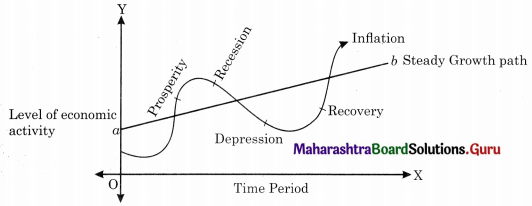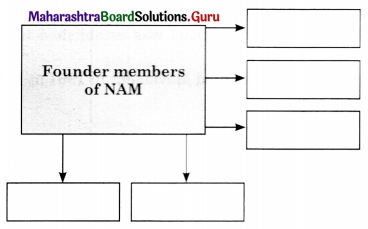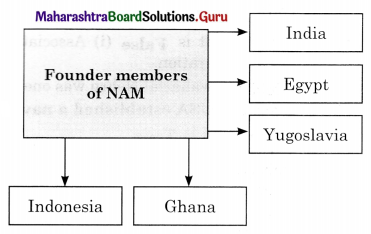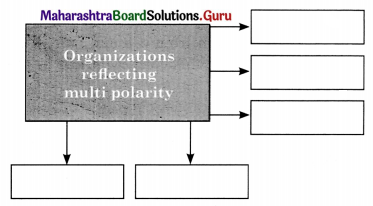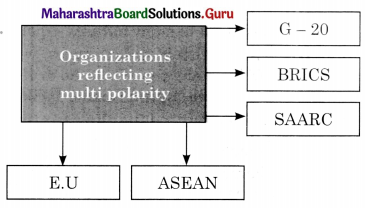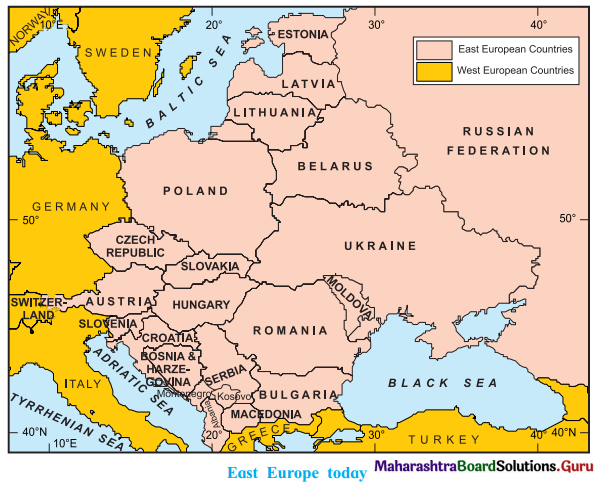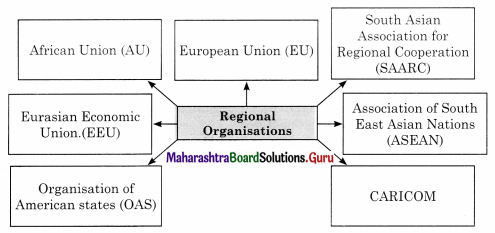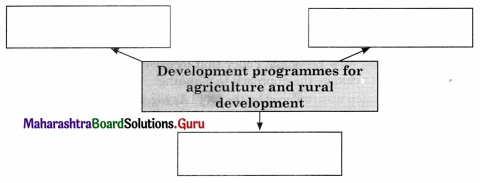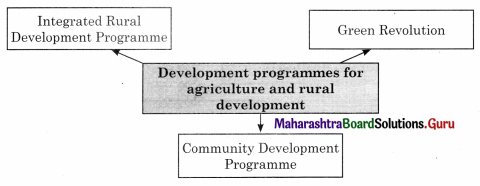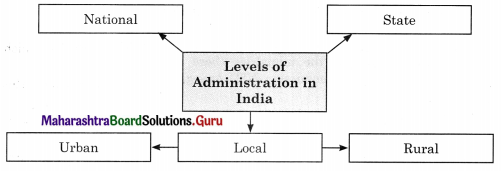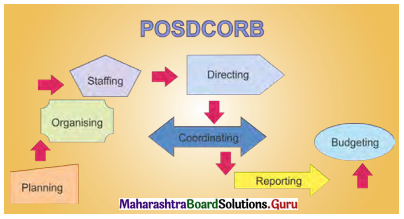Balbharti Maharashtra State Board Class 11 Economics Important Questions Chapter 6 Population in India Important Questions and Answers.
Maharashtra State Board 11th Economics Important Questions Chapter 6 Population in India
1A. Choose the correct option:
Question 1.
Effects of population explosion
(a) Decreased pressure on agriculture
(b) Increased pressure on land
(c) Inflation
(d) Low national income
Options:
(1) a, b, c
(2) b, c, d
(3) a, b, d
(4) a, c
Answer:
(2) b, c, d
Question 2.
Social measures to check population explosion
(a) Spread of education
(b) improving the status of women
(c) raising the minimum age of marriage
(d) expansion of the industrial sector
Options:
(1) a, b, c
(2) b, c, d
(3) b, d
(4) c, d
Answer:
(1) a, b, c
![]()
Question 3.
Economic measures to check population explosion
(a) expansion of the industrial sector
(b) removal of poverty
(c) improving the status of women
(d) Disaster management
Options:
(1) a, b
(2) a, b, c
(3) b, c, d
(4) a, b, d
Answer:
(4) a, b, d
Question 4.
Population Policy of India
(a) Family planning programme
(b) Mid-day meal programme
(c) Family welfare programme
(d) National population policy
Options:
(1) a, d
(2) b, c
(3) a, c, d
(4) a, b, c
Answer:
(3) a, c, d
Question 5.
Features of National Population Policy, 2000
(a) Delay marriage age of girls
(b) Free and compulsory education up to age of 20
(c) Achieve a stable population by 2050
(d) Prevention and control of the communicable disease.
Options:
(1) a, b, c
(2) b. c, d
(3) a, d
(4) b, d
Answer:
(3) a, c, d
1B. Complete the correlation:
Question 1.
1st Transition stage : Low growth of population : : 2nd Transition stage : ____________
Answer:
High growth of population
Question 2.
____________ : Cause of high birth rate : : Use of Nutritious food : Cause of low death rate.
Answer:
Illiteracy
![]()
Question 3.
Family Planning Programme : 1979 : : National Population Policy : ____________
Answer:
2000
Question 4.
Economic measure to check population : Removal of poverty : : ____________ : Social measure to check population.
Answer:
Improving the status of women
Question 5.
Theory of Population Growth : ____________ : : Theory of Demographic Transition : Coale and Hoover.
Answer:
Thomas Robert Malthus
1C. Give economic terms:
Question 1.
Natural resources exceed population growth.
Answer:
Underpopulation
Question 2.
Population growth exceeds the availability of natural resources.
Answer:
Overpopulation
Question 3.
Programme introduced (renamed) to reduce the birth rate in 1979.
Answer:
Family Welfare Programme
Question 4.
The policy was introduced to reduce the birth rate in 2000.
Answer:
National Population Policy
Question 5.
The proportion of working people to the total population is high.
Answer:
Demographic dividend
![]()
Question 6.
Preference for male children.
Answer:
Son meta – preference.
1D. Arrange in proper order:
Question 1.
Growth of population in India
(a) Year of Great Divide
(b) Population explosion
(c) Marginal decline in population
(d) Increase in population
Options:
(1) a, b, c, d
(2) a, c, b, d
(3) c, a, d, b
(4) b, a, c, d
Answer:
(3) c, a, d, b
Question 2.
Stages of Demographic Transition
(a) Decline in birth rate and death rate
(b) Low growth of population
(c) Rapid fall in death rate
Options:
(1) a, b, c
(2) b, c, a
(3) c, a, b
Answer:
(2) b, c, a
Question 3.
Population Policy in India
(a) Family welfare programme
(b) National population policy
(c) Family planning programme
Options:
(1) a, b, c
(2) b, c, a
(3) c, a, b
Answer:
(3) c, a, b
1E. Find the odd word out:
Question 1.
Concepts related to population growth
Birth rate, Death rate, Survival rate, Interest rate.
Answer:
Interest rate
![]()
Question 2.
Causes of high birth rate
Illiteracy, Preference, for male child, Expansion of industrial sector, Joint family system.
Answer:
Expansion of industrial sector
1F. Complete the following statements:
Question 1.
Population statistics are compiled and published by the ____________
Answer:
Office of the Registrar General and Census Commissioner of India
Question 2.
On 11th July, 1987, world population crossed ____________
Answer:
500 crores
Question 3.
World Population day is observed every year on ____________
Answer:
11th July
Question 4.
The Census Commissioner of India designated the year 1921 as the ____________
Answer:
‘Year of Great Divide’
Question 5.
Birth rate is also called as ____________
Answer:
fertility rate
Question 6.
Death rate is also called as ____________
Answer:
mortality rate
![]()
Question 7.
Survival rate = ____________
Answer:
Birth rate – Death rate
Question 8.
Difference between birth rate and death rate is know as ____________
Answer:
survival rate
Question 9.
The number of death per 1000 of the living population during a year is called ____________
Answer:
death rate
Question 10.
Theory of demographic transition is given by ____________
Answer:
A. J. Coale and E. M. Hoover
Question 11.
The situation where the growth of population is faster than the growth of the economy is called ____________
Answer:
population explosion
Question 12.
In India marriage is considered as ____________
Answer:
social and religious obligations
Question 13.
To continue having children in hope of son is known as ____________
Answer:
son meta – preference
Question 14.
Under the situation of optimum population, there is a balance between ____________
Answer:
population growth and natural resources
![]()
Question 15.
Demographic dividend occurs when the proportion of ____________
Answer:
working people to total population is high.
1G. Choose the wrong pair:
Question 1.
| Group ‘A’ | Group ‘B’ |
| (i) Malthusian Theory | (a) Thomas Robert Malthus |
| (ii) Kautilya | (b) Samajshashtra |
| (iii) World Population Day | (c) 11th July |
| (iv) 1921 | (d) Year of Great Divide |
Answer:
Wrong Pair: Kautilya – Samajshashtra
Question 2.
| Group ‘A’ | Group ‘B’ |
| (i) Population Policy | (a) Family Welfare Programme |
| (ii) Effects of population explosion | (b) Increased pressure on land |
| (iii) Overpopulation | (c) Population growth < Natural Resources |
| (iv) Theory of Demographic Transition | (d) Coale and Hoover |
Answer:
Wrong Pair: Overpopulation – Population growth < Natural Resources
1H. Choose the correct pair:
Question 1.
| Group ‘A’ | Group ‘B’ |
| (1) Census | (a) Survival rate |
| (2) High birth rate | (b) Population per sq. km. |
| (3) Density of population | (c) Universal marriage |
| (4) Difference between birth rate and death rate | (d) Method of computing population |
Options:
(1) 1-d, 2-c, 3-b, 4-a
(2) 1-b, 2-c, 3-d, 4-a
(3) 1-b, 2-a, 3-c, 4-d
(4) 1-c, 2-d, 3-a, 4-b
Answer:
(1) 1-d, 2-c, 3-b, 4-a
Question 2.
| Group ‘A’ | Group ‘B’ |
| (1) 1921 | (a) 121.02 crores |
| (2) 2011 Census | (b) The year of great divide |
| (3) Family Planning | (c) Mortality rate |
| (4) Death rate | (d) Planned parenthood |
Options:
(1) 1-d, 2-c, 3-a, 4-b
(2) 1-b, 2-c, 3-d, 4-a
(3) 1-b, 2-a, 3-d, 4-c
(4) 1-c, 2-d, 3-a, 4-b
Answer:
(3) 1-b, 2-a, 3-d, 4-c
Question 3.
| Group ‘A’ | Group ‘B’ |
| (1) Family Welfare Programme | (a) 2000 |
| (2) National Population Policy | (b) 1952 |
| (3) Infant Mortality Rate in 2011 | (c) 1979 |
| (4) Family Planning Programme | (d) 47 per 1000 |
Options:
(1) 1-d, 2-c, 3-a, 4-b
(2) 1-b, 2-c, 3-d, 4-a
(3) 1-b, 2-a, 3-c, 4-d
(4) 1-c, 2-a, 3-d, 4-b
Answer:
(4) 1-c, 2-a, 3-d, 4-b
![]()
2. Distinguish between:
Question 1.
Birth Rate and Death Rate.
Answer:
| Birth Rate | Death Rate |
| (i) Birth rate refers to a number of births per 1000 of living population per year. | (i) Death rate refers to a number of deaths per 1000 of living population per year. |
| (ii) Since 1921, the birth rate is falling gradually. | (ii) Since 1921, the death rate is falling rapidly. |
| (iii) A high birth rate is caused by early marriage, lack of family planning, illiteracy, etc. | (iii) A high death rate is caused by lack of medical facilities, poverty, malnutrition, etc. |
| (iv) Birth rate can be controlled by late marriages, family planning, etc. | (iv) Death rate can be controlled by better medical facilities, social welfare programmes, etc. |
| (v) According to the 2011 census, the birth rate in India is 20.97. | (v) According to the 2011 census, the death rate in India is 7.48. |
3. Answer the following:
Question 1.
What economic measures do you suggest to check population growth?
Answer:
To control the size of the population, economic measures can ensure a permanent solution.
These measures are:
- Expansion of industrial sector to shift the disguisedly unemployed people in rural areas to industries.
- Creation of employment opportunities in rural areas by starting labor-intensive industries.
- Equitable distribution of national income and removal of poverty, as the size of the family, is linked with poverty.
Question 2.
What social measures do you suggest to check population growth?
Answer:
The population problem is also a social problem and is related to illiteracy, superstitions, orthodoxy, pitiable condition of women, etc.
The following social measures must be undertaken:
- Education: Improvement in education changes the attitude of people towards family, marriage, and the number of children. Mostly educated people delay their marriage and prefer to have small families.
- Improvement in the conditions of women: Discrimination against women in social and economic life should be removed by the government.
- Raising the age of marriage: The marriage age of boys and girls should be raised and offenders should be punished by law.
![]()
Question 3.
Explain about Population Policy of India.
Answer:
Population policy was implemented through the following programmes:
- Family Planning Programme: Family planning refers to planned parenthood. It means limiting the size of the family by choice and not by chance. The family planning programme was introduced by the Government of India in 1952.
- Family Welfare Programme: ‘Family Planning Programme’ was renamed as ‘Family Welfare Programme’ in 1979. It tried to implement family planning services with maternal, child health, and nutrition.
- National Population Policy, 2000: It was introduced in 2000 to control population and improve its quality by giving free and compulsory education up to the age of 14 years, reduce infant and maternal mortality rate, universal immunization of children, delayed marriage for girls, etc.
Question 4.
Explain the Theory of Demographic Transition.
Answer:
The theory of demographic transition (birth rate and death rate related changes) given by Coale and Hoover explains that every country passes through three stages of demographic transition. It explains the changes taking place from high to low birth and death rates.
- First Stage: During the first stage, the country is at a low level of economic development. Agriculture is said to be the main occupation, people are illiterate and are ruled by old customs and beliefs. Hence in this stage, the country experiences a high birth rate and high death rate, and the actual growth of the population is low.
- Second Stage: Due to the improvement in economic development, the death rate starts falling rapidly, but the birth rate remains almost stable. This leads to widening the difference between the two, resulting in a very fast rise in the growth of population. Developing countries including India experiences this stage.
- Third Stage: As economic development continues, the structure of the economy changes, people shift from rural to urban areas, literacy rate improves, and in this stage, both birth rate and death rate fall, and there is low but stable population growth. Developed countries experience this stage.
Question 5.
Explain the concepts related to population growth.
Answer:
The concepts related to population growth are birth rate, death rate, and survival rate.
- Birth rate: The number of births occurring per 1000 of the living population during a year is called as Birth rate. It is also called as “fertility rate”.
- Death rate: The number of deaths occurring per 1000 of the living population during a year is called the Death rate. It is also called as “mortality rate”.
- Survival rate: Survival rate shows the actual rate of population growth. It is calculated by deducting the Death rate from the Birth rate i.e. Survival rate = Birth rate – Death rate.
4. State with reasons whether you agree or disagree with the following statements:
Question 1.
The year 1921 is known as the “Year of Great Divide”.
Answer:
Yes, I do agree with the statement.
- Before 1921, both the birth rate and death rate were high. In fact, in 1921, the death rate was little more than the birth rate because in India 8 million people died in Bengal due to the epidemic – plague.
- But after 1921, although both birth rate and death rate started declining, the birth rate declined slowly while the death rate started declining rapidly due to medical facilities, control over natural calamities, etc.
- Hence, in the context of population growth, the year 1921 is a dividing line having negative growth of population. Therefore, the Census Commission of India has called this year the ‘Year of Great Divide”.
![]()
Question 2.
The family planning programme has been very successful in India.
Answer:
No, I do not agree with the statement.
- People in India hesitate to follow family planning because of illiteracy, ignorance, and superstitions.
- Also, poverty among the people does not allow them to buy birth control devices.
- Some religion does not believe in family planning.
- So, although this programme is successful among the educated people, it is not so successful among the poor.
Question 3.
India is in the second stage of demographic transition.
Answer:
Yes, I do agree with the statement.
- In the second stage of demographic transition, the country experiences a high birth rate and a declining death rate.
- India is experiencing the same where the birth rate is as high as 20.97 and the death rate as 7.48 in 2011 is declining so India is still in the developing stage.
- So, India is in the second stage of demographic transition.
Question 4.
India is not going through a population explosion.
Answer:
No, I do not agree with the statement.
- India is going through a population explosion because, in the post-independence period, the death rate has been falling rapidly while the birth rate is falling slowly. So survival rate is high.
- India’s population is growing at an alarming rate.
- India is the second most populated country in the world.
- In 1951, India’s population was 36.1 crores which have increased more than 3 times in 2011 to 121.02 crores. That is why the post-1951 period is described as a period of population explosion.
Question 5.
The birth rate in India is controlled.
Answer:
No, I do not agree with the statement.
- According to the 2011 census birth rate in India is 20.9 which is very high as compared to other developed countries,
- Main factors responsible for such a high birth rate are :
- Because of poverty, children at a very young age start helping their parents in earning. Hence, more children are welcomed.
- Religious and social attitudes in India are such that large families are preferred.
- Illiteracy, ignorance, and the non-availability of birth control devices are also responsible for the high birth rate in India.
- There is a lack of awareness of the need for family planning.
- Thus, the birth rate in India is not controlled but is very high.
![]()
5. Answer in detail:
Question 1.
Explain the measure to check population explosion.
Answer:
Population explosion is one of the big obstacles to development, thus attempts have to be made to control it. Measures to control population explosion can be classified into the following three groups:
- Economic Measures
- Social Measures
- Population Policy of India.
(i) Economic Measures:
- Expansion of industrial sector to shift the disguisedly unemployed people in rural areas to industries.
- Creation of employment opportunities in rural areas by starting labor-intensive industries.
- Equitable distribution of national income and removal of poverty, as the size of family, is linked with poverty.
(ii) Social Measures: Population problem is also a social problem and related to illiteracy, superstitions, orthodoxy, pitiable condition of women, etc.
The following social measures must be undertaken.
- (a) Education: Improvement in education changes the attitude of people towards family, marriage, and the number of children. Mostly educated people delay their marriage and prefer to have small families.
- (b) Improvement in the conditions of women: Discrimination against women in social and economic life should be removed by the government.
- (c) Raising the age of marriage: The marriage age of boys and girls should be raised and offenders should be punished by law.
(iii) Population Policy of India:
- Family Planning Programme: Family planning refers to planned parenthood. It means limiting the size of the family by choice and not by chance. The family planning programme was introduced by the Government of India in 1952.
- Family Welfare Programme: This programme tries to integrate various families. This programme deals with maternal, child health, and nutrition issues of the society.
- National Population Policy, 2000: It was introduced to control population and to improve the quality of population, through various measures like free education, reducing infant mortality and maternal mortality rate, etc.















